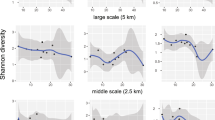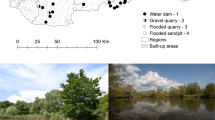Abstract
Odonata (dragonflies and damselflies) are good indicators of climate change effects due to their fast response to climatic variables such as temperature, humidity and amount of rainfall. This study aims to investigate the effect of three scenario of climate change at a regional scale (New Aquitaine region, France) on 59 odonata species distribution using species distribution modeling methods. Those results allow to identify species that will be the most impacted by climate change but also to evaluate changes in odonata diversity across the study area, through the calculation of diversity indices for each climate scenario. 24–33% of the species are predicted loss between 75 and 100% of suitable habitat by 2100 under two scenarios. Predicted distribution map can be use by managers, and stakeholders to target areas to be protect in priority. Different approaches can be pursued: protections of areas that are suitable or will be suitable in the future for rare species and/or target areas that will be suitable for high number of species leading to a higher diversity. By protecting wetland suitable for diverse odonata species, other wetland affiliated species such as amphibians, birds, and plants might benefits from those actions.
Access this chapter
Tax calculation will be finalised at checkout
Purchases are for personal use only
Similar content being viewed by others
References
Allouche O, Tsoar A, Kadmon R (2006) Assessing the accuracy of species distribution models: Prevalence, kappa and the true skill statistic (TSS). J Appl Ecol 43(6):1223–1232. https://doi.org/10.1111/j.1365-2664.2006.01214.x
Austin MP, Van Niel KP (2011) Improving species distribution models for climate change studies: Variable selection and scale. J Biogeogr 38(1):1–8. https://doi.org/10.1111/j.1365-2699.2010.02416.x
Bailleux G, Couanon V, Gourvil P-Y, Soulet D (2017) Pré-atlas des odonates d’Aquitaine—Synthèse des connaissances 1972—2014. CEN Aquitaine, LPO Aquitaine, p 117
Barbet-Massin M, Thuiller W, Jiguet F (2010) How much do we overestimate future local extinction rates when restricting the range of occurrence data in climate suitability models? Ecography 33(5):878–886. https://doi.org/10.1111/j.1600-0587.2010.06181.x
Braunisch V, Coppes J, Arlettaz R, Suchant R, Schmid H, Bollmann K (2013) Selecting from correlated climate variables : A major source of uncertainty for predicting species distributions under climate change. Ecography 36(9):971–983
Cerini F, Stellati L, Luiselli L, Vignoli L (2020) Long-term shifts in the communities of odonata : Effect of chance or climate change? North-Western Journal of Zoology 16(1):1–6
Dingemanse NJ, Kalkman VJ (2008) Changing temperature regimes have advanced the phenology of Odonata in the Netherlands. Ecological Entomology 33(3):394–402. https://doi.org/10.1111/j.1365-2311.2007.00982.x
Drias. (2020). Drias, Les futurs du climat—Accueil. http://www.drias-climat.fr/
Elith J, Leathwick JR (2009) Species distribution models : Ecological explanation and prediction across space and time. Annu Rev Ecol Evol Syst 40(1):677
Elith J, Kearney M, Phillips S (2010) The art of modelling range-shifting species. Methods Ecol Evol 1(4):330–342. https://doi.org/10.1111/j.2041-210X.2010.00036.x
Erwin KL (2008) Wetlands and global climate change : The role of wetland restoration in a changing world. Wetlands Ecol Manage 17(1):71. https://doi.org/10.1007/s11273-008-9119-1
FAUNA (2020) FAUNA—Accueil. https://observatoire-fauna.fr/
Franklin J (2009) Moving beyond static species distribution models in support of conservation biogeography. Divers Distrib 16(3):321–330
Hassall C (2012) Predicting the distributions of under-recorded Odonata using species distribution models. Insect Conservation and Diversity 5(3):192–201. https://doi.org/10.1111/j.1752-4598.2011.00150.x
Hassall C, Thompson DJ (2008) The effects of environmental warming on Odonata : A review. International Journal of Odonatology 11(2):131–153
Heikkinen RK, Luoto M, Araújo MB, Virkkala R, Thuiller W, Sykes MT (2006) Methods and uncertainties in bioclimatic envelope modelling under climate change. Prog Phys Geogr 30(6):751–777
Heller NE, Zavaleta ES (2009) Biodiversity management in the face of climate change : A review of 22 years of recommendations. Biol Cons 142(1):14–32. https://doi.org/10.1016/j.biocon.2008.10.006
Hijmans RJ, Graham C (2006) The ability of climate envelope models to predict the effect of climate change on species distributions. Glob Change Biol 12(12):2272–2281. https://doi.org/10.1111/j.1365-2486.2006.01256.x
IPCC (2014) Climate Change 2014 : Impacts, Adaptation, and Vulnerability. Working Group II Contribution to the IPCC 5th Assessment Report. Cambridge University Press, Cambridge, UK and New York, USA
Iturbide M, Bedia J, Gutiérrez JM (2018) Background sampling and transferability of species distribution model ensembles under climate change. Global Planet Change 166:19–29. https://doi.org/10.1016/j.gloplacha.2018.03.008
Jaeschke A, Bittner T, Reineking B, Beierkuhnlein C (2013) Can they keep up with climate change?–Integrating specific dispersal abilities of protected Odonata in species distribution modelling. Insect Conserv Divers 6(1):93–103
Keil P, Simova I, Hawkins BA (2008) Water-energy and the geographical species richness pattern of European and North African dragonflies (Odonata). Insect Conservation and Diversity 1(3):142–150. https://doi.org/10.1111/j.1752-4598.2008.00019.x
Kramer-Schadt S, Niedballa J, Pilgrim JD, Schröder B, Lindenborn J, Reinfelder V, Stillfried M, Heckmann I, Scharf AK, Augeri DM (2013) The importance of correcting for sampling bias in MaxEnt species distribution models. Divers Distrib 19(11):1366–1379
Kujala H, Moilanen A, Gordon A (2018) Spatial characteristics of species distributions as drivers in conservation prioritization. Methods Ecol Evol 9(4):1121–1132. https://doi.org/10.1111/2041-210X.12939
Le Treut, H (2020) Anticipating climate change in Nouvelle-Aquitaine. To guide policy at local level—Executive report. Éditions AcclimaTerra 2020, p 96
Leggott M, Pritchard G (1986) Thermal preference and activity thresholds in populations of Argia vivida (Odonata : Coenagrionidae) from habitats with different thermal regimes. Hydrobiologia 140(1):85–92
Lémond J, Dandin P, Planton S, Vautard R, Pagé C, Déqué M, Franchistéguy L, Geindre S, Kerdoncuff M, Li L (2011) DRIAS: a step toward Climate Services in France. Adv Sci Res 6(1):179–186
Mallard F (coord) (2017) Programme les sentinelles du climat. Tome IV : Ajustement des protocoles d’échantillonnage et analyses exploratoires des indicateurs des effets du changement climatique sur la biodiversité en Nouvelle-Aquitaine. C. Nature. https://hal.archives-ouvertes.fr/hal-02022916
Mallard F (coord) (2018) Programme les sentinelles du climat. Tome VI : Résultats exploratoires des indicateurs des effets du changement climatique sur la biodiversité en Nouvelle-Aquitaine. C. Nature. https://hal.archives-ouvertes.fr/hal-02060363
Mallard F (coord) (2019) Programme les sentinelles du climat. Tome VIII : Écologie du changement climatique en région Nouvelle-Aquitaine. C. Nature. https://hal.archives-ouvertes.fr/hal-02495935
Mallard F (coord) (2020) Programme les sentinelles du climat. Tome IX : Connaitre et comprendre pour protéger les espèces animales et végétales face au changement climatique, C. Nature : Le Haillan, Gironde, 822p. https://hal.science/hal-03130349
Mallard F (2021a) Climate Sentinels program : Meeting the Challenge of regional biodiversity conservation adaptation to climate change. In: Leal Filho W, Luetz J, Ayal D (eds) Handbook of climate change management. Springer, Cham, pp 1–39. https://doi.org/10.1007/978-3-030-22759-3_193-1.
Mallard F (coord) (2021b) Programme les sentinelles du climat—Tome X: Réponses des espèces animales et végétales face au changement climatique et pistes d’actions de conservation de la biodiversité en région Nouvelle-Aquitaine. C. Nature, Le haillan (Gironde). https://hal.inria.fr/hal-03647259/
Mallard F, Couderchet L (2019) Climate sentinels research program : Developing indicators of the effects of climate change on biodiversity in the region of New Aquitaine (south west, France). In: Leal Filho W, Barbir J, Preziosi R (eds) Handbook of climate change and biodiversity. Climate change management. Springer, Cham, pp 223–241 https://doi.org/10.1007/978-3-319-98681-4_14.
Morghad F, Samraoui F, Touati L, Samraoui B (2019) The times they are a changin’ : Impact of land-use shift and climate warming on the odonate community of a Mediterranean stream over a 25-year period. Vie Et Milieu-Life and enVironment 69(1):25–33
Ott J (2001) Expansion of Mediterranean Odonata in Germany and Europe—Consequences of climatic changes. In “Fingerprints” of climate change. Springer, New York, pp 89–111
Ouzeau G, Déqué, M, Jouini, M, Planton, S, Vautard, R (2014) Le climat de la France au XXI siècle Volume 4, scénarios régionalisés: Édition 2014 pour la métropole et les régions d’outre-mer (No 4). Ministère de l’écologie et du développement durable, pp 1–64
Phillips SJ, Anderson RP, Schapire RE (2006) Maximum entropy modeling of species geographic distributions. Ecol Model 190(3–4):231–259. https://doi.org/10.1016/j.ecolmodel.2005.03.026
R Core Team (2020) R: a language and environment for statistical computing. R Foundation for Statistical Computing. https://www.R-project.org/
Termaat T, van Strien AJ, van Grunsven RHA, De Knijf G, Bjelke U, Burbach K, Conze K-J, Goffart P, Hepper D, Kalkman VJ, Motte G, Prins MD, Prunier F, Sparrow D, van den Top GG, Vanappelghem C, Winterholler M, WallisDeVries MF (2019) Distribution trends of European dragonflies under climate change. Divers Distrib 25(6):936–950. https://doi.org/10.1111/ddi.12913
Thuiller W, Brotons L, Araújo MB, Lavorel S (2004) Effects of restricting environmental range of data to project current and future species distributions. Ecography 27(2):165–172
Thuiller W, Lafourcade B, Engler R, Araújo MB (2009) BIOMOD–a platform for ensemble forecasting of species distributions. Ecography 32(3):369–373
Wisz MS, Hijmans R, Li J, Peterson AT, Graham C, Guisan A, NCEAS Predicting Species Distributions Working Group (2008) Effects of sample size on the performance of species distribution models. Divers Distrib 14(5):763–773
Acknowledgements
This work would not have been possible without support from the European Union (the European Regional Development Fund—Feder), the French region of New Aquitaine, and the French departments of “Gironde” and “Pyrénées-Atlantiques.” We thank these organizations for their support and funding from 2016 to 2021, as well as our technical partners Météo France and Conservatory of Natural Area of Aquitaine (CEN). We also thank the members of the 2016–2019 Scientific Council of the program, including Hervé Le Treut, Honorary President of the Scientific Council, Professor at Pierre and Marie Curie University, for their opinions, analyses, advice, and validation of the methods, protocols, models, and results. Finally, we thank Akaren Goudiaby, Pierre-Yves Gourvil, and Gilles Bailleux for sharing their knowledge on Odonata and their useful remarks on the model results.
Author information
Authors and Affiliations
Corresponding author
Editor information
Editors and Affiliations
Rights and permissions
Copyright information
© 2023 The Author(s), under exclusive license to Springer Nature Switzerland AG
About this chapter
Cite this chapter
Glad, A., Mallard, F. (2023). Spatial Distribution Modeling of Odonata in the New Aquitaine Region (France): A Tool to Target Refuge Areas Under Climate Change. In: Leal Filho, W., Kovaleva, M., Alves, F., Abubakar, I.R. (eds) Climate Change Strategies: Handling the Challenges of Adapting to a Changing Climate. Climate Change Management. Springer, Cham. https://doi.org/10.1007/978-3-031-28728-2_26
Download citation
DOI: https://doi.org/10.1007/978-3-031-28728-2_26
Published:
Publisher Name: Springer, Cham
Print ISBN: 978-3-031-28727-5
Online ISBN: 978-3-031-28728-2
eBook Packages: Earth and Environmental ScienceEarth and Environmental Science (R0)




